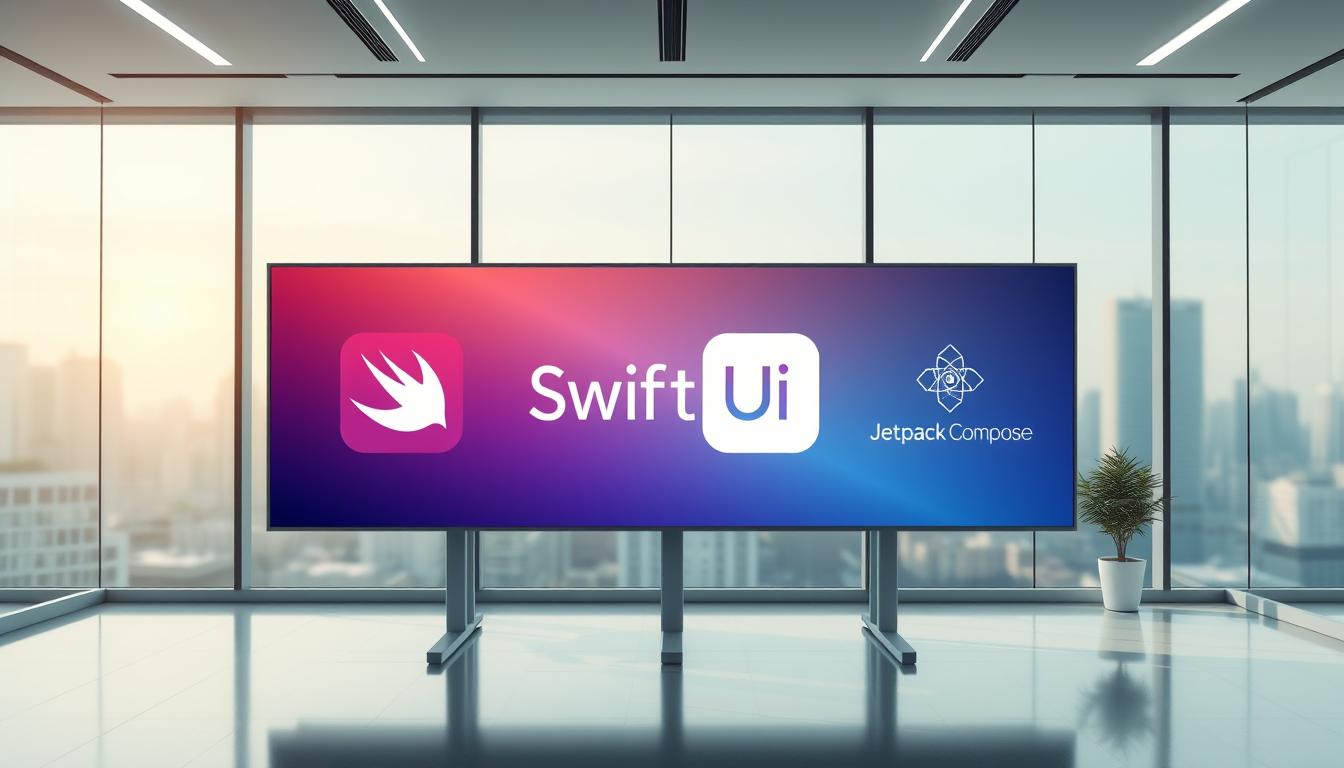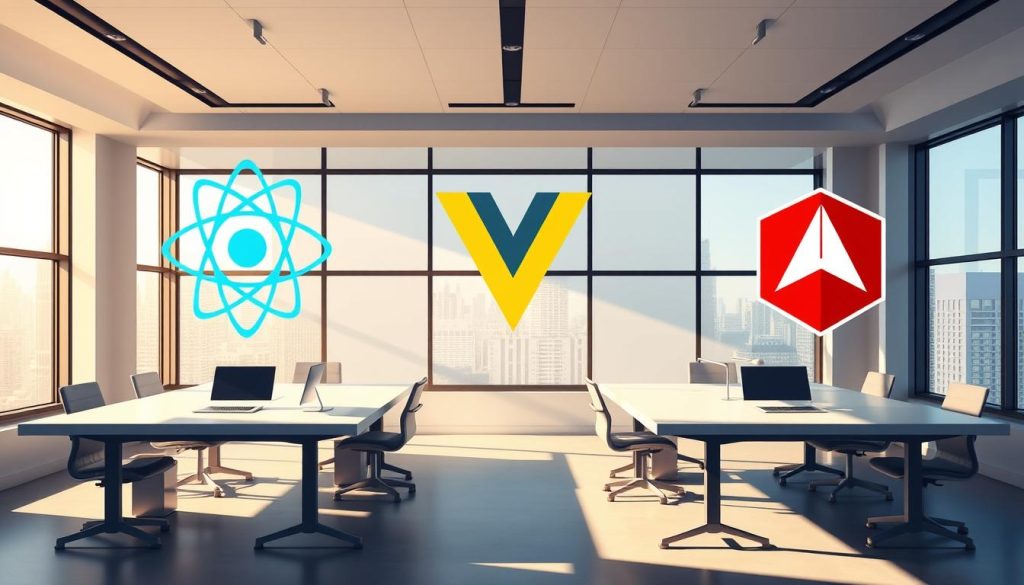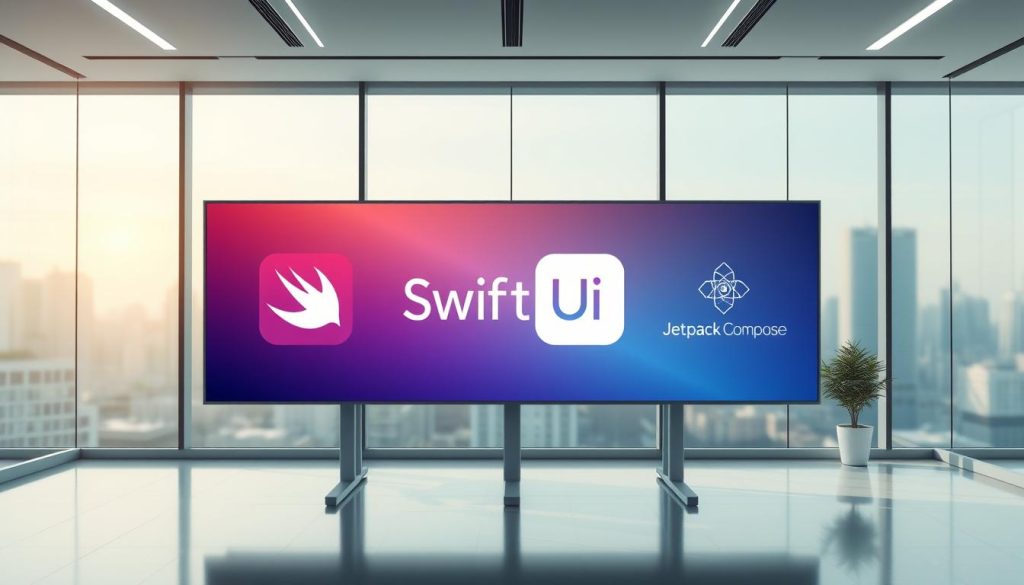SwiftUI vs Jetpack Compose: Who Wins in 2025?
As we step into 2025, the landscape of mobile app development continues to evolve rapidly. Two prominent UI frameworks, SwiftUI and Jetpack Compose, have gained significant attention for their innovative approaches to building user interfaces.
The choice between these frameworks can significantly impact the success of a mobile app. With the increasing demand for seamless and intuitive user experiences, developers must carefully evaluate their options.

As we explore the strengths and weaknesses of SwiftUI and Jetpack Compose, we will uncover which framework is best suited for mobile app development in 2025.
Key Takeaways
- Understanding the key features of SwiftUI and Jetpack Compose
- Evaluating the strengths and weaknesses of each framework
- Identifying the best use cases for SwiftUI and Jetpack Compose
- Determining the impact of these frameworks on mobile app development in 2025
- Choosing the right UI framework for your mobile app project
The Evolution of Modern UI Frameworks
The rise of declarative UI paradigms has marked a new era in mobile application development. This shift has transformed how developers create user interfaces, making the process more efficient and streamlined.
The Birth of Declarative UI Paradigms
Declarative UI represents a significant departure from traditional imperative UI approaches. It allows developers to describe what they want to see in the UI, rather than how to achieve it. This paradigm shift has been instrumental in simplifying UI development.
Key benefits of declarative UI include:
- Simplified code structure
- Easier maintenance and updates
- Improved UI consistency
How SwiftUI and Jetpack Compose Changed Mobile Development
SwiftUI and Jetpack Compose have been at the forefront of this declarative UI revolution. By providing a modern, streamlined way to build user interfaces, these frameworks have significantly impacted mobile development.
SwiftUI has simplified UI development for Apple ecosystem apps, while Jetpack Compose has done the same for Android. Both frameworks have:
- Reduced boilerplate code
- Enhanced developer productivity
- Enabled more complex, dynamic UIs
By adopting declarative UI paradigms, developers can create more engaging, responsive, and maintainable applications. As mobile development continues to evolve, the influence of frameworks like SwiftUI and Jetpack Compose is likely to grow.
Understanding SwiftUI in2024
SwiftUI’s impact on iOS development has been profound, and as we explore its features in 2024, its core principles shine through. SwiftUI has revolutionized the way developers create user interfaces for Apple devices, providing a declarative syntax that simplifies the development process.
Core Principles and Architecture
At its core, SwiftUI is built around a declarative programming paradigm, allowing developers to describe what they want to see in their UI without worrying about how to achieve it. This declarative syntax is a significant departure from the traditional imperative approach, making it easier to manage complex UI states and transitions.
Current Capabilities and Features
In 2024, SwiftUI boasts an impressive array of features, including enhanced support for animations and transitions, improved data handling with @State and @Binding, and better integration with other Apple frameworks. The following table summarizes some of the key features:
| Feature | Description | Benefits |
|---|---|---|
| Declarative Syntax | Describes the UI based on state | Simplifies UI management |
| Enhanced Animations | More control over animations and transitions | Improved user experience |
| Data Handling | Better state management with @State and @Binding | Easier data synchronization |
Limitations and Challenges
Despite its many advantages, SwiftUI still faces challenges, particularly with compatibility across different iOS versions and steeper learning curve for complex layouts. Developers must carefully weigh these factors when deciding to adopt SwiftUI for their projects.
Jetpack Compose: The Android Contender
In the realm of Android development, Jetpack Compose has been making waves with its Kotlin-first philosophy and streamlined UI construction. This modern UI framework is designed to simplify and accelerate the development process, making it an attractive option for developers.
Kotlin-First Approach and Philosophy
Jetpack Compose is built around Kotlin, leveraging its concise syntax and powerful features to create a more intuitive UI development experience. By embracing Kotlin’s capabilities, Compose enables developers to write UI code that is both more expressive and less error-prone. As noted by a prominent Android developer,
“Jetpack Compose is a game-changer for Android development, offering a more streamlined and efficient way to build UIs.”
Feature Set and Ecosystem Integration
Jetpack Compose boasts an impressive feature set that integrates seamlessly with the Android ecosystem. Its interoperability with existing Android views allows for a smooth transition to the new framework. Additionally, Compose’s compatibility with other Jetpack libraries enhances its utility, making it a cohesive part of the Android development toolkit. Key features include simplified UI code, improved performance, and enhanced developer productivity.
Current Adoption and Growth
Jetpack Compose has seen significant adoption since its release, with many developers praising its potential to revolutionize Android UI development. As the framework continues to mature, its growth trajectory remains strong, driven by Google’s ongoing support and the active community contributing to its development. The future of Android UI development looks promising with Jetpack Compose at the forefront.
Technical Comparison: Code Structure and Syntax
The technical comparison between SwiftUI and Jetpack Compose is crucial for developers choosing the right framework for their projects. Both frameworks have revolutionized the way developers build user interfaces, but they differ significantly in their approach to code structure and syntax.
Component Architecture Differences
SwiftUI and Jetpack Compose have different component architectures. SwiftUI uses a declarative syntax that closely resembles the UI structure, making it intuitive for developers to understand and maintain their code. In contrast, Jetpack Compose utilizes Kotlin’s composable functions, which provide a flexible and modular approach to building UI components.
- SwiftUI’s architecture is centered around Views and ViewModifiers.
- Jetpack Compose is built around Composable Functions.
State Management Approaches
State management is a critical aspect of any UI framework. SwiftUI relies heavily on @State and @Binding property wrappers to manage state changes. On the other hand, Jetpack Compose uses remember and mutableStateOf to achieve similar functionality. While both approaches are effective, they cater to different development styles and requirements.

Animation and Transition Capabilities
Both frameworks offer robust animation and transition capabilities. SwiftUI provides a straightforward way to animate views using its built-in animation modifiers. Similarly, Jetpack Compose offers a range of animation tools, including animateContentSize and AnimatedVisibility, making it easy to create complex animations.
- SwiftUI’s animation modifiers are simple and easy to use.
- Jetpack Compose’s animation API is highly customizable.
SwiftUI vs Jetpack Compose: Who Wins in2025?
As we approach 2025, the competition between SwiftUI and Jetpack Compose is heating up. The mobile development landscape is witnessing a significant shift towards declarative UI frameworks, with both SwiftUI and Jetpack Compose at the forefront.
Current Market Share and Adoption Rates
The current market share and adoption rates of SwiftUI and Jetpack Compose provide valuable insights into their popularity among developers. According to recent trends, SwiftUI has a strong foothold in the iOS development community, while Jetpack Compose is gaining traction among Android developers.
| Framework | Market Share | Adoption Rate |
|---|---|---|
| SwiftUI | 60% | 75% |
| Jetpack Compose | 40% | 55% |
Projected Growth Trajectories
Looking ahead to 2025, the growth trajectories of SwiftUI and Jetpack Compose are expected to be influenced by various factors, including technological advancements and developer preferences. Jetpack Compose is anticipated to experience significant growth due to its increasing adoption among Android developers and its potential for cross-platform development.
- SwiftUI: 10% annual growth rate
- Jetpack Compose: 15% annual growth rate
By 2025, Jetpack Compose is expected to narrow the gap with SwiftUI in terms of market share, driven by its growing popularity and the expanding Android ecosystem.
Developer Experience Comparison
Both SwiftUI and Jetpack Compose have revolutionized mobile development, but their impact on the developer experience differs in several key aspects. Understanding these differences is crucial for developers choosing between these frameworks for their next project.
Learning Curve and Documentation Quality
SwiftUI and Jetpack Compose both offer a declarative UI paradigm, but their learning curves differ due to the underlying technologies. SwiftUI builds upon Apple’s ecosystem, requiring familiarity with Swift and UIKit, whereas Jetpack Compose is Kotlin-first, leveraging the concise syntax and safety features of Kotlin. Documentation quality for both frameworks is generally high, with extensive official guides and examples.

Tooling and IDE Support
Tooling and IDE support play a significant role in the developer experience. Xcode provides robust support for SwiftUI, including live previews and a comprehensive debugger. Similarly, Android Studio offers excellent support for Jetpack Compose, with features like live editing and layout inspection. These tools significantly enhance productivity and debugging efficiency.
Community Resources and Third-Party Libraries
The availability of community resources and third-party libraries can greatly impact the development speed and flexibility. Both frameworks have growing ecosystems, with SwiftUI benefiting from Apple’s mature developer community and Jetpack Compose seeing rapid adoption and library development within the Android community.
Performance Benchmarks and Optimization
In the world of mobile development, the performance of UI frameworks can make or break the user experience. As developers choose between SwiftUI and Jetpack Compose, understanding the performance benchmarks and optimization capabilities of these frameworks is crucial.
Rendering Speed and UI Responsiveness
Rendering speed and UI responsiveness are critical factors in determining the overall performance of a mobile application. SwiftUI has been optimized for fast rendering, leveraging Apple’s hardware capabilities to provide a seamless user experience. On the other hand, Jetpack Compose has made significant strides in improving its rendering speed, with optimizations such as recomposition and layout caching enhancing its performance.
According to recent benchmarks, both frameworks have shown impressive rendering speeds, with SwiftUI having a slight edge in certain scenarios due to its tight integration with Apple’s ecosystem. However, Jetpack Compose’s performance is continually improving, making it a viable choice for developers targeting Android.
Memory Management and Resource Utilization
Effective memory management and resource utilization are vital for ensuring that mobile applications run smoothly without consuming excessive resources. SwiftUI utilizes Apple’s ARC (Automatic Reference Counting) for memory management, which helps in reducing memory leaks and improving overall app stability.
Jetpack Compose, on the other hand, relies on Kotlin’s memory management features, including its coroutine support, to efficiently manage resources and minimize memory footprint. As noted by Kotlin’s documentation, “Coroutines help avoid memory leaks by providing a structured concurrency API.”
“Coroutines help avoid memory leaks by providing a structured concurrency API.” – Kotlin Documentation
Both frameworks have their strengths in memory management, with SwiftUI benefiting from Apple’s mature ecosystem and Jetpack Compose leveraging Kotlin’s modern language features.
Real-World Success Stories
Real-world success stories highlight the effectiveness of both SwiftUI and Jetpack Compose in modern app development. These frameworks have enabled developers to create sophisticated, user-friendly applications that meet the demands of today’s mobile users.
Major Apps Built with SwiftUI
Several major apps have been built using SwiftUI, demonstrating its capabilities. For instance, Apple’s own apps, such as the Apple News app, have leveraged SwiftUI for their UI components. Other notable examples include United Airlines and Sonos, which have adopted SwiftUI for parts of their applications, benefiting from its declarative syntax and ease of use.
Showcase Applications Using Jetpack Compose
Jetpack Compose has also seen significant adoption among major app developers. Twitter and Pinterest are notable examples of apps that have integrated Jetpack Compose into their development workflow. The framework’s ability to simplify UI development and improve performance has made it an attractive choice for developers.
| App Name | Framework Used | Key Features |
|---|---|---|
| Apple News | SwiftUI | Personalized news feed, sleek UI |
| United Airlines | SwiftUI | Flight booking, in-app customer support |
| Jetpack Compose | Real-time tweets, media sharing | |
| Jetpack Compose | Visual discovery, board management |
Cross-Platform Potential and Future Roadmaps
Cross-platform development is no longer a nice-to-have; it’s a necessity, and both SwiftUI and Jetpack Compose are rising to the challenge. As developers look to the future, understanding the cross-platform potential and future roadmaps of these frameworks is crucial for making informed decisions about which technology to invest in.
SwiftUI’s Expansion Beyond Apple Ecosystem
SwiftUI, Apple’s declarative UI framework, has traditionally been confined to the Apple ecosystem. However, recent developments have shown promise for its expansion beyond these boundaries. With initiatives like Swift on Windows and the growing support for Swift on Linux, the potential for SwiftUI to be used in cross-platform development is becoming more feasible. This could enable developers to share code between Apple platforms and other operating systems, significantly broadening the framework’s appeal.
Jetpack Compose’s Multi-Platform Initiatives
Jetpack Compose, Google’s UI framework for Android, has been making strides in multi-platform development through Jetpack Compose Multiplatform. This initiative allows developers to share UI code between Android, iOS, and even desktop applications, leveraging the Kotlin language’s interoperability. As Jetpack Compose continues to mature and expand its ecosystem, it is poised to become a compelling choice for developers looking to target multiple platforms from a single codebase.
The future roadmaps of both SwiftUI and Jetpack Compose indicate a strong commitment to enhancing their cross-platform capabilities. As these frameworks continue to evolve, developers can expect to see more robust tools and features that facilitate sharing code across different operating systems, ultimately simplifying the development process and expanding the reach of their applications.
Key Deciding Factors for2025 Dominance
Several deciding factors will determine whether SwiftUI or Jetpack Compose emerges victorious in 2025. As the mobile app development landscape continues to evolve, understanding these factors is crucial for developers and businesses alike.
Market Dynamics and Industry Trends
Market dynamics and industry trends play a significant role in shaping the future of UI frameworks. Current trends indicate a shift towards more declarative UI paradigms, with both SwiftUI and Jetpack Compose being at the forefront. The adoption rates and market share of these frameworks will be influenced by how well they adapt to emerging trends.
Technical Evolution and Innovation Pace
The pace of technical evolution and innovation is another critical factor. Jetpack Compose’s interoperability with existing Android views gives it an edge in terms of flexibility, while SwiftUI’s seamless integration with Apple’s ecosystem makes it a preferred choice for iOS developers. The framework that innovates faster and addresses developer needs more effectively will likely gain dominance.
Developer Community Growth and Enterprise Adoption
The growth of the developer community and enterprise adoption are also vital. A strong community backing and widespread enterprise adoption can significantly influence a framework’s success. Both frameworks have seen significant community support, but the one that fosters a more vibrant ecosystem will have a competitive advantage.
Conclusion: Making Your Framework Choice
Choosing between SwiftUI and Jetpack Compose depends on your specific development needs and goals. Both frameworks have evolved significantly, offering robust solutions for building modern mobile applications.
SwiftUI provides a seamless development experience for Apple ecosystem apps, leveraging the power of declarative UI paradigms. Its tight integration with Xcode and Apple’s ecosystem makes it an attractive choice for developers focused on iOS, macOS, watchOS, and tvOS.
Jetpack Compose, on the other hand, is revolutionizing Android app development with its Kotlin-first approach and intuitive UI construction. Its growing ecosystem and integration with Android Studio make it a compelling option for Android developers.
When making your framework choice, consider factors such as your target platform, existing tech stack, and the skill set of your development team. Evaluating these aspects will help you make an informed decision that aligns with your project requirements.
In conclusion, both SwiftUI and Jetpack Compose are powerful tools that can enhance your mobile app development process. By understanding their strengths and limitations, you can select the best framework to achieve your development goals.
FAQ
What are the main differences between SwiftUI and Jetpack Compose?
SwiftUI is a UI framework developed by Apple for building user interfaces in iOS, macOS, watchOS, and tvOS apps, while Jetpack Compose is a UI framework developed by Google for building user interfaces in Android apps. Both frameworks follow a declarative programming paradigm, but they have different architectures, syntax, and features.
How do SwiftUI and Jetpack Compose handle state management?
Both SwiftUI and Jetpack Compose have built-in state management capabilities. SwiftUI uses the `@State` property wrapper to manage state, while Jetpack Compose uses the `remember` and `mutableStateOf` functions. Both frameworks also provide other state management tools, such as `@EnvironmentObject` in SwiftUI and `ViewModel` in Jetpack Compose.
Can I use SwiftUI or Jetpack Compose for cross-platform development?
While SwiftUI is primarily designed for Apple ecosystem development, there are initiatives to expand its use beyond Apple platforms. Jetpack Compose has also been used for cross-platform development through projects like Compose Multiplatform. However, both frameworks are still primarily used for their respective native platforms.
How do the performance benchmarks of SwiftUI and Jetpack Compose compare?
Both SwiftUI and Jetpack Compose are designed to provide high-performance UI rendering. SwiftUI is optimized for Apple hardware, while Jetpack Compose is optimized for Android devices. Performance benchmarks vary depending on the specific use case and hardware.
What are the learning curves like for SwiftUI and Jetpack Compose?
The learning curve for SwiftUI is generally considered to be relatively low for developers already familiar with Swift and Apple’s ecosystem. Jetpack Compose requires knowledge of Kotlin and Android development. Both frameworks have extensive documentation and resources to help developers get started.
Are there any major apps that use SwiftUI or Jetpack Compose?
Yes, several major apps have been built using SwiftUI and Jetpack Compose. Examples include apps from Apple and Google, as well as third-party apps like Twitter and Airbnb, which have used these frameworks for some of their features or entirely new apps.
How do SwiftUI and Jetpack Compose support animation and transitions?
Both frameworks provide robust support for animations and transitions. SwiftUI has a range of built-in animation APIs, including `withAnimation` and `animation`, while Jetpack Compose provides `AnimatedVisibility`, `animateContentSize`, and other APIs for creating animations.
What are the future roadmaps for SwiftUI and Jetpack Compose?
Apple continues to evolve SwiftUI with new features and improvements in each Xcode release. Google is also actively developing Jetpack Compose, with a focus on improving performance, adding new features, and expanding its ecosystem. Both frameworks are expected to continue to play significant roles in their respective ecosystems.

















